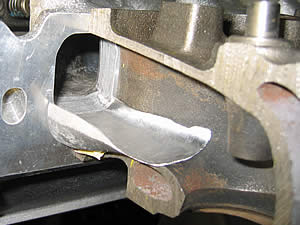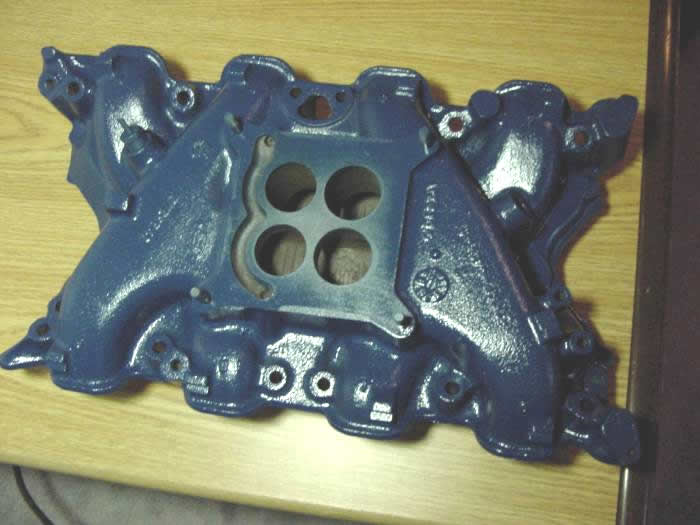Thank's barnett468, I would be really interested to see that. I have searched everywhere for some kind of comparisons.
OK, here it is
CLEVELAND INTAKE DYNO COMPARISON
http://pantera.infopop.cc/eve/forums/a/tpc/f/5650045562/m/994102665
http://www.the351cforum.com/viewtopic.php?f=3&t=82
HEAD PORTING INFO
First of all, i am in no way a professional cylinder head porter, however, I do know a few people that are and have discussed porting with them to some degree on several occasions . . i have also built many clevo engines . . i am also aware of actual back to back tests of stock heads vs ported heads, and in all of these tests, the peak hp was increased . . it is definitely possible that others may not have had the same results and if they didn't it is simply because the porting they had was different than the porting that was done on the tests i am aware of . . yo may have heard before that it is easy to screw a head up by porting it if it is not done properly and this is definitely correct . . porting is a science and the use of wet flow benches helps to actually see what is going on, however, seeing what is going on is absolutely useless unless understands what effect what they are seeing will have on performance.
below is a comment from Jon Kaase . . He has won the annual engine masters challenge 5 times so he has established his credibility and you will notice that he did a back to back test on a head where it had turbulence that reduced flow so he tested it that way then corrected the turbulence which greatly increased flow but it didn't increase power and he has absolutely no idea why . . if a guy that won the biggest engine building challenge in the world whom was also the engine builder for a top NHRA driver has absolutely no idea what happened in his test, it shows that this stuff is not easy and what would seem logical and may work on paper just may not work that way in actual application when the engine hits the dyno or the tires hit the pavement.
"In 1975 I bought my first flow bench, a used bench top Superflow. The first head I checked was a ported 351 Cleveland 4-V. Of course it went turbulent at .700". Well, 31 years later I still don't have all the answers for this problem. I am once again faced with it in our SCJ and P-51 Ford big block heads. I know right where it's at; looking down the port on the right side of the floor at the short turn the air won't follow the turn and breaks away and tumbles. If you wet flow it you can see the air circle around in the chamber and go back in the valve bowl. It might be an area about 1/2" wide at the seat. I've never seen it in a Hemi or Pro Stock head because the ports are higher and don't make as severe of a turn. When the port comes in from down on the deck, and the head flows lots of air, and the port is configured like a Cleveland, it's one of the things that you run into. The big question (that I'm still trying to find the answer to) is does this really occur when the engine is running and if it does will is hurt the power? I'm sure there are ways to fix it that will lose power. With all the pulses and pressure waves and fuel mixed in the air going on in the intake port, who's to say? We take care of a Douglass Dauntless SBD-5 WWII dive bomber that belongs the Confederate Air Force. One day I noticed an air channel that goes from under the front of the wing and exits at the top of the back of the wing. The guys told me that during high angles of attack, it put air back in the place where it goes turbulent. It makes the control surfaces still work. You know where I'm going with this! I came home and went to work on some SCJ heads. I installed a 5/16" thin wall stainless tube that went from the intake floor through the water jacket and exited just above the seat ring, right at the point where the air breaks away. It went right through the short turn rise, parallel with the deck. It completely cured the turbulence. I did all 8 ports. With the hole open they all flowed about 410. With the hole plugged, they backed up and flowed about 375. When I dynoed it, it made 750 with the holes open. Then I put little plugs in the tubes, and it still made 750. I went back and forth 2 more times. it just didn't matter. From 375 to 410 CFM at .600" and it made no difference. So does it really happen when it's running? I still don't know for sure! ... Kaase"
STOCK VS PORTED DYNO RESULTS
Below is just one of several back to back cylinder head porting tests that shows an increase by simply porting the heads . . Even though two different sets of heads were used, it is still a valid test because in stock form, both sets of heads are basically identical . . A Boss 302 head is basically a 4V Cleveland head that Ford put on a 302 engine or vise versa.
The increase in power by simply increasing air flow was a whopping 54 HP and 24 TQ, and the hp increase was achieved with just a tiny 200 rpm increase.
The Boss 302 heads were ported a fair amount but not as much as they could have been, so even with the moderate porting that was done, there was a big increase in hp and tq.
A 1 point increase in compression will increase hp and tq everywhere by around 3.5 - 4% . .
CAM ................................ Crane Hyd Roller p/n 529801 . 290 294 . 228 232 . 597 609 . lsa 112
COMPRESSION ............. Max of around 10.2:1 but may have been slightly different between heads.
ROD LENGTH ................. 6.0
INTAKE MANIFOLD ........ Stock cast iron 4V Cleveland with 1" spacer.
CARBURETOR ............... 950 cfm
ENGINE .......................... Cleveland stroked to 383
HEADERS ...................... 4 into 1 with 1 3/4" tubes 3" collector
DYNO TYPE ................... DTS
TEST a. - STOCK UNMODIFIED 4V HEADS CHAMBER AND VALVE SIZE UNKNOWN
TEST b. - PORTED BOSS 302 HEADS CHAMBER AND VALVE SIZE UNKNOWN IN FLOW 325 EX FLOW 234
TEST c. - INSTALL TUNNEL RAM ON SAME BOSS 302 HEADS
a. HP 432 @ 5700 .... TQ 439 @ 4000
b. HP 486 @ 5900 .... TQ 463 @ 4800
c. HP 523 @ . N/A .... TQ 476 @ . N/A
.








